Amano R.S., Sunden B. (Eds.) Computational Fluid Dynamics and Heat Transfer: Emerging Topics
Подождите немного. Документ загружается.

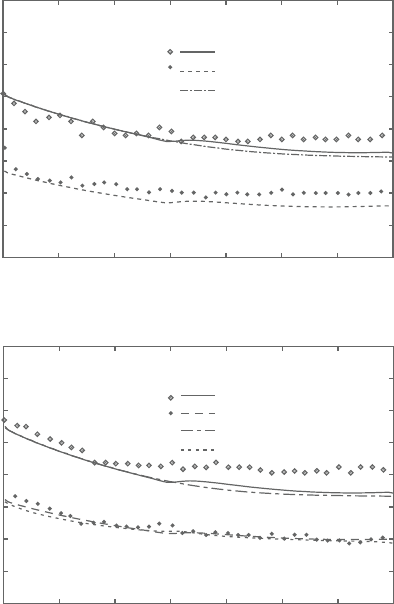
Sunden CH009.tex 25/8/2010 10: 57 Page 346
346 Computational Fluid Dynamics and Heat Transfer
(a)
0
50
a [W/(m
2
K )]a [W/(m
2
K )]
100
150
200
250
300
350
400
0 100 200 300 400 500 600 700
x(mm)
Element height = 0.5 mm: h = 0.55 mm
Expt. AWF + CLS
:U
0
= 40 m/s
:U
0
= 22 m/s
:U
0
= 40 m/s; straight
(b)
0
50
100
150
200
250
300
350
400
0 100 200 300 400 500 600 700
x(mm)
Element height = 0.75 mm: h = 0.825 mm
Expt. AWF + CLS
:U
0
= 40 m/s
:U
0
= 22 m/s
:U
0
= 40 m/s; straight
:U
0
= 22 m/s; fine mesh
Figure 9.11. Heat transfer coefficient distribution in convex rough wall boundary
layers at Pr=0.71.
Computations are consistent with this experimental observation. Note that the
present curvature effects are of the entrance region of the convex wall. Due to
the sudden change of the curvature rate, the pressure gradient becomes locally
strongernearthestartingpoint oftheconvexwallresultinginflowaccelerationand
thus heat transfer enhancement.
Sand dune flow. Figure 9.12 shows the geometry and a computational mesh used
for a water flow over a sand dune of van Mierlo and de Ruiter [29]. Their exper-
imental rig consisted of a row of 33 identical 2D sand dunes covered with sand
paper, whose averaged sand grain height was 2.5mm. Since they measured the
flowfield aroundoneofthe centraldunesofthe row, streamwiseperiodicboundary
conditions are imposed in the computation. In the experiments, the free surface
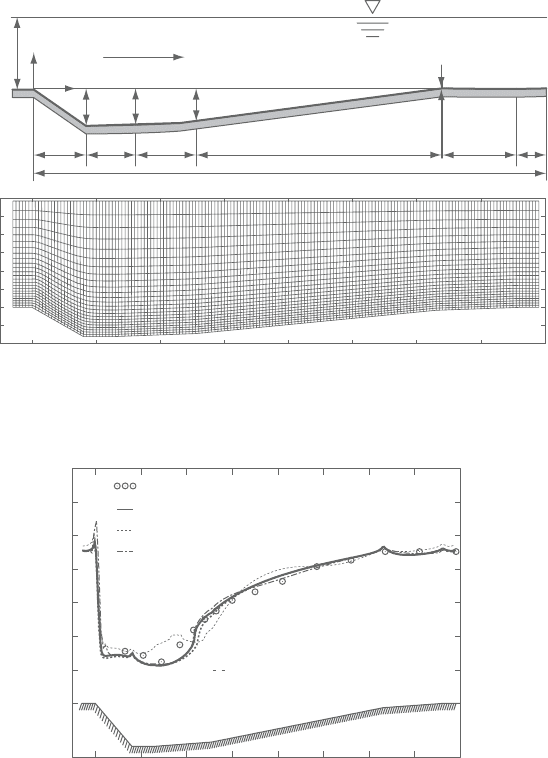
Sunden CH009.tex 25/8/2010 10: 57 Page 347
AWFs of turbulence for complex surface flow phenomena 347
−0.1
−0.05
0
0.05
0.1
0.15
0.2
0.25
0.3
0 0.2 0.4 0.6 0.8 1 1.2 1.4 1.6
y (m)
x (m)
165 × 25
Water flow
160 100 250 750
1600
260 80
8
y
x
292
80
80
72
Figure 9.12. Dune profile and computational g rid.
−0.05
0.0
0.05
0.1
0 0.2 0.4 0.6 0.8 1 1.2 1.4 1.6
U
τ
/U
b
x (m)
Expt.
Grid 165 × 25 (LWF + CLS)
Grid 329 × 50 (AWF + CLS)
Grid 165 × 50 (AWF + CLS)
Grid 165 × 25 (AWF + CLS)
Figure 9.13. Friction velocity over the sand dune.
was located at y =292mm and the bulk mean velocity was U
b
=0.633m/s. Thus,
the Reynolds numberbased on U
b
and thesurface heightwas 175,000.In this flow,
a large recirculation zone appears behind the dune. Due to the flow geometry, the
separation point is fixed at x =0m as in a back-step flow.
Figure 9.13 compares the predicted friction velocity distribution on meshes of
330×50, 165×50 and 165×25. In the finest and coarsest meshes, the heights of
the first cell facing the wall are, respectively, 4 and 8mm, and larger than thegrain
height of 2.5mm which corresponds to h
+
75 at the inlet.The turbulence model
Sunden CH009.tex 25/8/2010 10: 57 Page 348
348 Computational Fluid Dynamics and Heat Transfer
applied is the cubic CLS k-ε model with the differential length-scale correction
term for the dissipation rate equation [30]. The lines of the predicted profiles are
almost identical to one another, proving that the AWF is rather insensitive to the
computational mesh. (In the following discussions on flow field quantities, results
by the finest mesh of 330×50 are used.)
Figure9.13 also showsthe result by theLWF.Although the LWF, equation (36)
should perform reasonably in flat plate boundary layer type of flows, it is obvious
that the LWF produces an unstable wiggled profile in the recirculating region of
0m< x< 0.6m. The computational costs by the AWF and the LWF are almost
the same as each other, with the more complex algebraic expressions of theAWF
requiring slightly more processing time.
Figure 9.14 compares flow field quantities predicted by the CLS and the LS
models with the AWF. In the distribution of the mean velocity and the Reynolds
shear stress, both models agree reasonably well with the experiments as shown in
Figure 9.14a and b while the CLS model predicts the streamwise normal stress
better than the LS model (Figure 9.14c).These predictive trends of the models are
consistent with those in separating flows by the original LRN versions and thus it
is confirmed that coupling with the AWF preserves the original capabilities of the
LRN models.
Ramp flow. Figure 9.15 illustrates the flow geometry and a typical computational
mesh (220×40) used for the computations of the channel flows with a ramp on
the bottom wall by Song and Eaton [31]. A 2D wind tunnel whose height was
152mm with a ramp (height H =21mm, length L=70mm, radius R=127mm)
was used in their experiments. Air flowed from the left at a free stream velocity
U
e
=20m/s with developed turbulence (Re
θ
=3,400 at x =0mm for the smooth
wallcase; Re
θ
=3,900 fortherough wall case). Since for the rough wall case sand
paper with an averaged grain height of 1.2mm, which corresponds to h
+
100 at
x =0mm, covered theramp part, the heightof thefirstcomputational cellfrom the
wall is set as 1.5mm. (Note that since the location of the separation point is not
fixed in this flow case, the grid sensitivity test, which is not shown here, suggests
that unlike in the other flow cases large wall adjacent cell heights affect prediction
of the recirculation zone.) This flow field includes an adverse pressure gradient
along the wall and a recirculating flow whose separation point is not fixed, unlike
in the sand dune flow. The measured velocity fields implied that the recirculation
regionextendedbetween0.74≤x
(:x/L)≤1.36and0.74< x
≤ 1.76inthesmooth
and rough wall cases, respectively. Thus, relatively finer streamwise resolution is
applied to the computational mesh around the ramp part.
Figure 9.16 compares the predicted pressure coefficients of the smooth wall
case by the AWF and the standard LWF with the results of the LRN computation.
The turbulence model used is the CLS model. The first grid nodes from the wall
(y
1
) are located at y
+
1
=15∼150 for the wall-function models while those for the
LRN are located at y
+
1
≤0.2. (The mesh used for the LRN case has 100 cells in
they direction.)Obviously, theAWFproducesprofilesthatareclosertothoseofthe
experiment than the profiles of the LWF model.TheAWF reasonably captures the
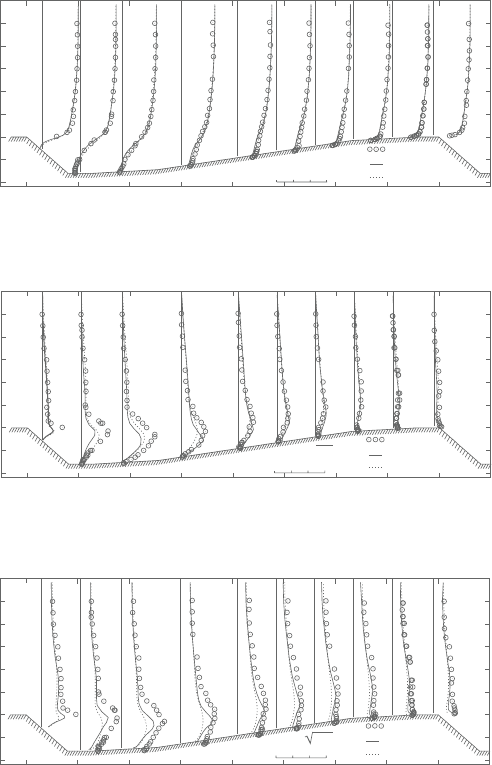
Sunden CH009.tex 25/8/2010 10: 57 Page 349
AWFs of turbulence for complex surface flow phenomena 349
(c)
−0.1
−0.05
0
0.05
0.1
0.15
0.2
0.25
0.3
x (m)
0 0.2 0.4 0.6 0.8 1 1.2
0.0 0.3
1.4 1.6 1.8
Expt.
AWF+ CLS
AWF+LS
1.58x = 0.06 0.21 0.37 0.60 0.82 0.97 1.12 1.27 1.42
uu/U
b
(b)
−0.1
−0.05
0
0.05
0.1
0.15
0.2
0.25
0.3
x (m)
0 0.2 0.4 0.6 0.8 1 1.2 1.4 1.6 1.8
1.58x = 0.06 0.21 0.37 0.60 0.82 0.97 1.12 1.27 1.42
0.0 0.03
Expt.
AWF + CLS
AWF+LS
−uν/U
2
(a)
−0.1
−0.05
0
0.05
0.1
0.15
0.2
0.25
0.3
x (m)
y (m)y (m)y (m)
0 0.2 0.4 0.6 0.8 1 1.2 1.4 1.6 1.8
1.58x = 0.06 0.21 0.37 0.60 0.82 0.97 1.12 1.27 1.42
0.0 1.5
Expt.
AWF + CLS
AWF+LS
U/U
b
b
Figure 9.14. Mean velocityand Reynoldsstress distributionof thesanddune flow.
effectsofadversepressuregradientsduetotheinclusionofthesensitivitytopressure
gradients in its form. Hence, its predictive tendency is similar to that of the LRN
model.
Figure 9.17a compares the mean velocity profiles for both the smooth and
rough wall cases. For both the cases, the agreement between the experiments
and the predictions by the AWF coupled to the CLS model is reasonably good.
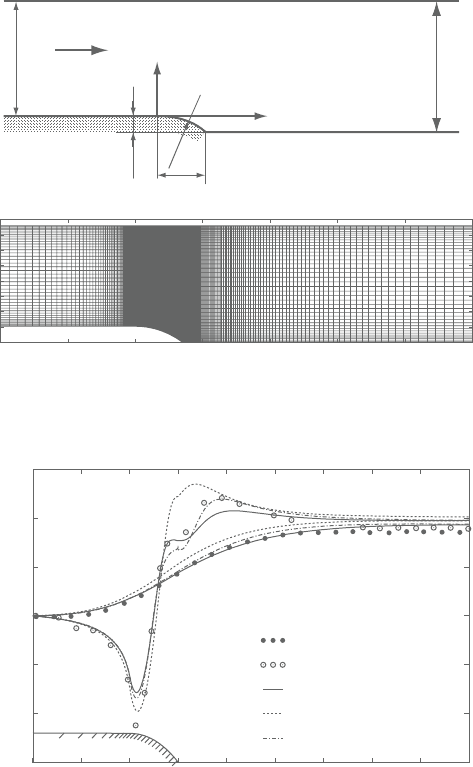
Sunden CH009.tex 25/8/2010 10: 57 Page 350
350 Computational Fluid Dynamics and Heat Transfer
L (70)
R (127)
H (21)
152
131
Flow
x
y
0
20
40
60
80
100
120
140
160
−200 −100
0 100 200 300 400 500
y (mm)
x (mm)
220×40
Figure 9.15. Ramp geometry and computational grid.
−0.3
−0.2
−0.1
0
0.1
0.2
0.3
−2 −1
0 1 2 3 4 5 6 7
C
p
x ′
Top wall (smooth), Expt.
Bottom wall (smooth), Expt.
AWF y
1
+
= 15∼150
LWF y
1
+
= 15∼150
LRN y
1
+
= ∼0.2
Figure 9.16. Pressurecoefficientdistributionofthesmoothrampflow;CLSisused
in all the computations.
The predicted recirculation zones are 0.69< x
< 1.40 and 0.57< x
< 1.60 in the
smooth and rough wall cases, respectively.They, however, do not correspond well
with the experimentally estimated ones. Figure 9.17b–d compare the distribution
of the Reynolds stresses at the corresponding locations to those in Figure 9.17a.
(The values are normalised by the reference friction velocity U
τ,ref
at x
=−2.0.)
Theagreementbetweenthepredictionandtheexperimentsisagainreasonablygood
for each quantity.
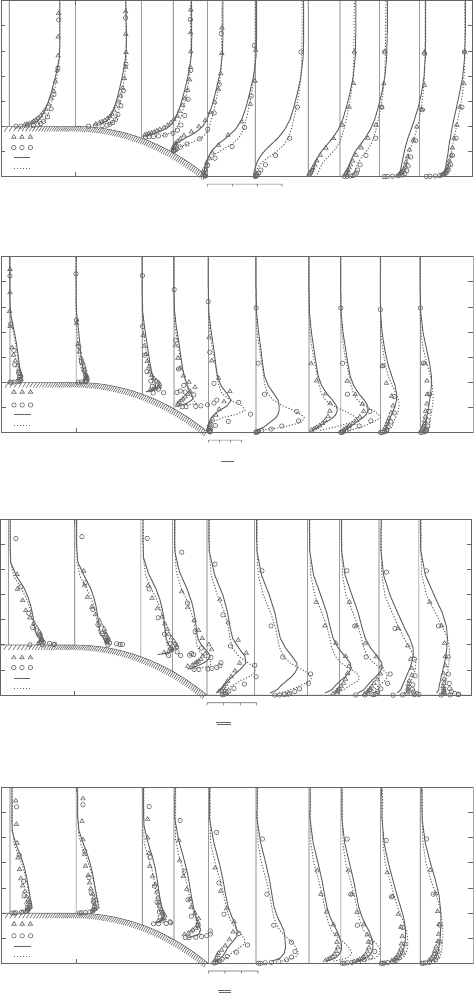
Sunden CH009.tex 25/8/2010 10: 57 Page 351
AWFs of turbulence for complex surface flow phenomena 351
x’= –2.00 0.00 0.50 0.74 1.00 1.36 1.76 2.00 4.00 7.00
(b)
–1
–0.5
0
0.5
1
1.5
2
2.5
y/H
–uν/U
2
τ,ref
Expt.(rough)
Expt.(smooth)
AWF+CLS(rough)
AWF+CLS(smooth)
0.03.0
x’= –2.00 0.00 0.50 0.74 1.00 1.36 1.76 2.00 4.00 7.00
(c)
–1
–0.5
0
0.5
1
1.5
2
2.5
y/H
√
uu/U
τ,ref
Expt.(rough)
Expt.(smooth)
AWF+CLS(rough)
AWF+CLS(smooth)
0.03.0
x’= –2.00 0.00 0.50 0.74 1.00 1.36 1.76 2.00 4.00 7.00
(d)
–1
–0.5
0
0.5
1
1.5
2
2.5
y/H
√
νν/U
τ
,ref
Expt.(rough)
Expt.(smooth)
AWF+CLS(rough)
AWF+CLS(smooth)
0.03.0
(a)
–1
–0.5
0
0.5
1
1.5
2
2.5
y/H
x’= –2.00 0.00 0.50 0.74 1.00 1.36 1.76 2.00 4.00 7.00
Expt.(rough)
Expt.(smooth)
AWF+CLS(rough)
AWF+CLS(smooth)
0.0 1.5
U/U
e
Figure 9.17. Mean velocity and Reynolds stress distribution of the ramp flow.
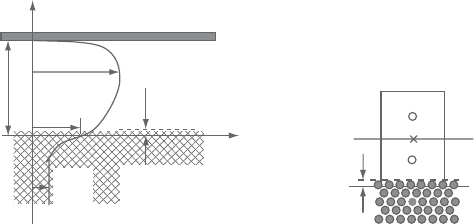
Sunden CH009.tex 25/8/2010 10: 57 Page 352
352 Computational Fluid Dynamics and Heat Transfer
9.4.4 AWF for permeable walls
Flows over permeable walls can be seen in many industrially impor tant devices
such as catalytic converters, metal foam heat exchangers and separators of fuel
cells. Some geophysical fluid flows, i.e. water flows over river beds etc., are often
concerned as flows over permeable surfaces as well.
The effects of a porous medium on the flow in the interface region between the
porous wall and clear fluid (named ‘interface region’hereafter) have been focused
on by many researchers. Due to the severer complexity of the flow phenomena,
however,experimentalturbulent flowstudiesintheinterfaceregionsareratherlim-
ited. Zippe and Graf [32] and others experimentally found that the friction factors
of turbulent flows over permeable beds became higher than those over imperme-
able walls with the same surface roughness. The recent DNS study of the interface
regionbyBreugemetal. [33]alsoindicatedthatthefrictionvelocitybecamehigher
associated with the increase of the permeability. All these results imply that the
wallpermeabilityeffectsonturbulenceshouldbesolelytakeninto accountforflow
simulations.
This part, thus, introduces an attempt [11] to construct anAWF which includes
the effects ofthewallpermeability aswellas the wall roughness forcomputing the
interface regions over porous media.
Modelling for porous/fluid interfacial turbulence
It is natural to consider a slip tangential velocity U
w
at the interface between a
clear fluid flow and a porous surface when one introduces a volume averaging
concept. Before discussing the slip velocity, it is essential to define a nominal
location of the interface. In some porous media, their outermost perimeter may
be reasonable as the interface [34]. This means when the pores are filled with
solidmaterial, asmoothimpermeableboundaryis recovered.However, incase that
a porous medium is composed of beads, the recovered impermeable surface has
some roughness by defining the pores as the spaces surrounded by the beads.This
definition is consistent with those in the experiments by Zippe and Graf [32] and
U
U
w
y
x
P
N
n
h
y = 0
H
h
(b)(a)
U
d
Porous
medium
Figure 9.18. (a)Velocity profile ofachannel flow overa porous medium, (b)near-
wall cell.

Sunden CH009.tex 25/8/2010 10: 57 Page 353
AWFs of turbulence for complex surface flow phenomena 353
others. Therefore, the surface roughness h of porous/fluid interface is considered
as in Figure 9.18a and that the interface is located at the bottom of the roughness
elements. In order to obtain the tangential velocity U
w
at the interface (y =0), the
velocity distribution in a porous medium is estimated as follows.
Following Whitaker [35], the volume averaged Navier-Stokes equations for
incompressible flows in isotropic porous media using the decomposition:
u
i
=u
i
f
+˜u
i
(47)
are:
∂u
i
f
∂t
+u
j
f
∂u
i
f
∂x
j
=−
1
ρ
∂p
f
∂x
i
+ ν
∂
2
u
i
f
∂x
2
j
−
∂τ
ij
∂x
j
+ f
i
(48)
∂u
i
∂x
i
= 0 (49)
where p, ρ, ν, and ϕ are, respectively, the pressure, the density, the kinematic
viscosity of the fluid and the porosityofthe porous medium.The volume averaged
values φ and φ
f
are superficial and intrinsic averaged values of a variable φ,
respectively. (The superficial averaging is defined by taking average of a variable
over a volume element of the medium consisting of both solid and fluid materials,
while the intrinsic averaging is defined over a volume consisting of fluid only.)
Between them the following relation exists:
φ=ϕφ
f
(50)
Although the sub-filter-scale dispersion ∂τ
ij
/∂x
j
needs a closure model as in large
eddy simulations, it could be neglected in porous media since it is small enough
compared with the other ter ms. As in Whitaker [35], the drag force f
i
in isotropic
porous media can be parametrised as:
f
i
−ν
u
j
K
ij
− ν
F
ij
u
k
K
jk
(51)
where K
ij
and F
ij
are, respectively, the permeability tensor and the Forchheimer
correction tensor. These tensors are empirically given by Macdonald et al. [37]
being based on the modified Ergun equation [36] as:
K
ij
=
d
2
p
ϕ
3
180(1 −ϕ)
2
@ AB C
K
δ
ij
(52)
F
ij
=
ϕ
100(1 −ϕ)
d
p
ν
@
AB C
F
(u
k
f
)
2
δ
ij
(53)
where d
p
is the mean particle diameter.

Sunden CH009.tex 25/8/2010 10: 57 Page 354
354 Computational Fluid Dynamics and Heat Transfer
Thus, by the Reynolds averaging of the volume averaged momentum equa-
tions one can obtain the following equations for a developed turbulent flow in a
homogeneous porous medium:
0 =−
1
ρ
∂P
∂x
−
∂
uv
∂y
+
ν
ϕ
∂
2
U
∂y
2
−
ν
K
U −
νϕF
K
qu
f
(54)
0 =−
1
ρ
∂P
∂y
−
∂
v
2
∂y
−
νϕF
K
qv
f
(55)
where q=
#
u
k
f
u
k
f
, u
i
u
j
= (u
i
f
− u
i
f
)(u
j
f
− u
j
f
), U =u, and
P =
p
f
.
In laminar flow cases where the permeability Reynolds number Re
K
≡
√
KU
τ
/ν, which is based on the permeability K and the friction velocity U
τ
,is
sufficiently small, the Reynolds stress and the Forchheimer drag terms can be
neglected:
0 =−
1
ρ
∂P
∂x
+
ν
ϕ
∂
2
U
∂y
2
−
ν
K
U (56)
0 =−
1
ρ
∂P
∂y
(57)
The solutionof the above equations (56)and (57), namely,the Brinkman equations
[38] is a decaying exponential function which meets the interfacial (slip) velocity
U
w
at y =0 and the Darcy velocity U
d
deep inside the porous medium.
U = U
d
+ (U
w
− U
d
)exp
y
?
ϕ
K
(58)
The Darcy velocity is:
U
d
=−
K
µ
∂P
∂x
(59)
In the case of high Re
K
, turbulent diffusion and Forchheimer drag terms in the
momentumequationsshouldbeconsideredandthustheirgeneralanalyticalsolution
cannot be easily obtained. Breugem et al. [33] found that a good approximation
of the turbulent flow inside the porous media can be obtained by the following
exponential formula:
U U
d
+ (U
w
− U
d
)exp
α
p
y
?
ϕ
K
(60)
where α
p
is an empirical coefficient. If Re
K
is small enough, α
p
=1. In very large
Re
K
cases, where the turbulent diffusion and the Forchheimer drag terms should

Sunden CH009.tex 25/8/2010 10: 57 Page 355
AWFs of turbulence for complex surface flow phenomena 355
balance each other out:
−
∂
uv
∂y
νϕF
K
qu
f
(61)
TheReynoldsstressestimatedwiththeeddyviscosity(ν
t
u
t
y; u
t
isanappropriate
velocity scale) and the velocity gradient from equation (60) leads to
−
uv = ν
t
1
ϕ
∂U
∂y
u
t
y
U
ϕ
α
p
?
ϕ
K
α
p
u
2
t
y
?
ϕ
K
(62)
then the LHS of equation (61) may be rewritten as
−
∂
uv
∂y
α
p
?
ϕ
K
u
2
t
(63)
Thus, α
p
can be estimated as
α
p
?
ϕ
K
u
2
t
νϕF
K
u
2
t
⇒ α
p
ν
?
ϕ
K
F (64)
Therefore, the following form can be a model for α
p
:
α
p
= f
α
p
+ (1 −f
α
p
)ν
?
ϕ
K
F (65)
f
α
p
= exp
−
Re
K
β
p
(66)
bridgingbetween1andν
√
ϕ/KFdependingonthepermeability. Byreferringtothe
distributionof thecoefficient α
p
obtainedfrom theDNS[33], themodel coefficient
β
p
can be functionalised as
β
p
=
90
Re
0.68
K
(67)
Hence
f
α
p
= exp
−
Re
1.68
K
90
(68)
(Note thatthe aboveform isrewrittenin a different way for theAWF as inequation
(73).)
Consequently, the slip velocity U
w
can be expressed as
U
w
= U
d
+
∂U/∂y|
y=0
α
p
√
ϕ/K
(69)
with the velocity gradient ∂U/∂y|
y=0
given by the AWF.
